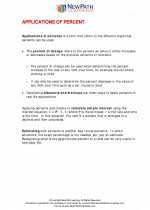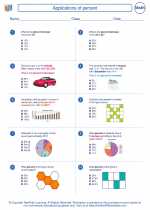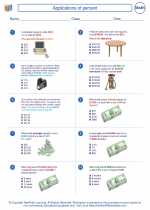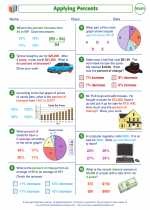Applications of percent -> count
Counting in Mathematics
In mathematics, counting is the process of determining the number of elements in a set. It is a fundamental concept that forms the basis for many other mathematical operations and concepts.
Counting Principles
There are several important principles and techniques related to counting in mathematics:
- Counting by Ones: This is the most basic form of counting, where each item in a set is counted one by one.
- Counting by Groups: Sometimes, it is more efficient to count items in groups rather than individually. This is especially useful when dealing with large numbers of items.
- Counting with Multiplication: In some cases, counting can be done using multiplication, especially when dealing with arrangements or combinations of items.
- Counting with Permutations and Combinations: These are advanced counting techniques used to calculate the number of possible arrangements or selections of items from a set.
Example Problems
Here are some example problems to practice counting:
- How many different ways can the letters in the word "MATH" be arranged?
- If a set contains 5 red balls, 3 blue balls, and 4 yellow balls, how many different combinations of 2 balls can be chosen?
- In a group of 15 students, how many different committees of 4 students can be formed?
Study Guide
To master the concept of counting in mathematics, it is important to practice various types of counting problems, including basic counting, permutations, and combinations. Here are some tips for studying counting:
- Understand the fundamental principles of counting, including the counting by ones, counting by groups, and counting with multiplication.
- Practice solving problems that involve arrangements and combinations of items, as well as determining the number of possible outcomes in different scenarios.
- Learn the formulas and techniques for calculating permutations and combinations, and practice applying them to different types of problems.
- Use visual aids and diagrams to help understand counting problems, especially when dealing with complex arrangements or selections.
By mastering the concept of counting, you will develop a strong foundation for more advanced mathematical concepts and problem-solving skills.
.◂Math Worksheets and Study Guides Eighth Grade. Applications of percent
Study Guide Applications of percent
Applications of percent  Worksheet/Answer key
Worksheet/Answer key Applications of percent
Applications of percent  Worksheet/Answer key
Worksheet/Answer key Applications of percent
Applications of percent  Worksheet/Answer key
Worksheet/Answer key Applications of percent
Applications of percent  Worksheet/Answer key
Worksheet/Answer key Applications of percent
Applications of percent 

 Worksheet/Answer key
Worksheet/Answer key
 Worksheet/Answer key
Worksheet/Answer key
 Worksheet/Answer key
Worksheet/Answer key
 Worksheet/Answer key
Worksheet/Answer key

The resources above cover the following skills:
Number and Operations (NCTM)
Understand numbers, ways of representing numbers, relationships among numbers, and number systems.
Work flexibly with fractions, decimals, and percents to solve problems.